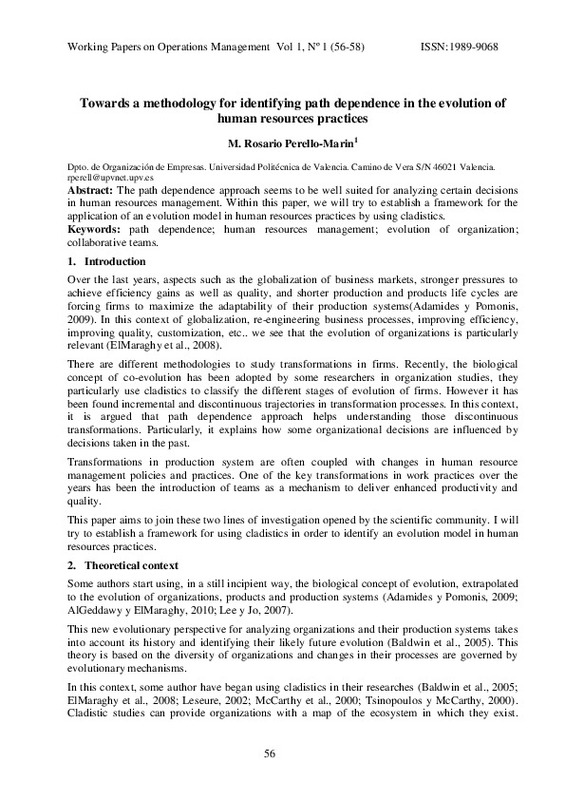JavaScript is disabled for your browser. Some features of this site may not work without it.
Buscar en RiuNet
Listar
Mi cuenta
Estadísticas
Ayuda RiuNet
Admin. UPV
Towards a methodology for identifying path dependence in the evolution of human resources practices
Mostrar el registro sencillo del ítem
Ficheros en el ítem
| dc.contributor.author | Perelló Marín, María Rosario
|
|
| dc.date.accessioned | 2011-03-25T10:13:06Z | |
| dc.date.available | 2011-03-25T10:13:06Z | |
| dc.date.issued | 2010 | |
| dc.identifier.uri | http://hdl.handle.net/10251/10591 | |
| dc.description.abstract | [EN] The path dependence approach seems to be well suited for analyzing certain decisions in human resources management. Within this paper, we will try to establish a framework for the application of an evolution model in human resources practices by using cladistics. | es_ES |
| dc.description.sponsorship | This project has received funding from Universidad Politecnica de Valencia, by the Project “arquitectura de las practicas de alto rendimiento de gestión de operaciones y gestión de recursos humanos: definición de los constructos, modelo factorial y establecimiento del path dependence” (PAID-06-09-2850). | |
| dc.language | Inglés | es_ES |
| dc.publisher | ROGLE - Departamento de Organización de Empresas - Universitat Politècnica de València | es_ES |
| dc.relation.ispartof | Working Papers on Operations Management | |
| dc.rights | Reserva de todos los derechos | es_ES |
| dc.subject | Path dependence | es_ES |
| dc.subject | Human resources management | es_ES |
| dc.subject | Evolution of organization | es_ES |
| dc.subject | Collaborative teams | es_ES |
| dc.title | Towards a methodology for identifying path dependence in the evolution of human resources practices | es_ES |
| dc.type | Artículo | es_ES |
| dc.date.updated | 2011-03-23T13:20:40Z | |
| dc.identifier.doi | 10.4995/wpom.v1i1.796 | |
| dc.relation.projectID | info:eu-repo/grantAgreement/UPV//PAID-06-09-2850/ | |
| dc.rights.accessRights | Abierto | es_ES |
| dc.contributor.affiliation | Universitat Politècnica de València. Facultad de Administración y Dirección de Empresas - Facultat d'Administració i Direcció d'Empreses | es_ES |
| dc.contributor.affiliation | Universitat Politècnica de València. Departamento de Organización de Empresas - Departament d'Organització d'Empreses | es_ES |
| dc.description.bibliographicCitation | Perelló Marín, MR. (2010). Towards a methodology for identifying path dependence in the evolution of human resources practices. Working Papers on Operations Management. 1(1):56-58. https://doi.org/10.4995/wpom.v1i1.796 | es_ES |
| dc.description.accrualMethod | SWORD | es_ES |
| dc.relation.publisherversion | https://doi.org/10.4995/wpom.v1i1.796 | |
| dc.description.upvformatpinicio | 56 | |
| dc.description.upvformatpfin | 58 | |
| dc.description.volume | 1 | |
| dc.description.issue | 1 | |
| dc.identifier.eissn | 1989-9068 | |
| dc.contributor.funder | Universitat Politècnica de València | |
| dc.description.references | Adamides, E. D., & Pomonis, N. (2009). The co-evolution of product, production and supply chain decisions, and the emergence of manufacturing strategy. International Journal of Production Economics, 121(2), 301-312. doi:10.1016/j.ijpe.2006.11.025 | es_ES |
| dc.description.references | AlGeddawy, T., & ElMaraghy, H. (2010). Co-evolution hypotheses and model for manufacturing planning. CIRP Annals, 59(1), 445-448. doi:10.1016/j.cirp.2010.03.032 | es_ES |
| dc.description.references | Baldwin, J. S., Allen, P. M., Winder, B., & Ridgway, K. (2005). Modelling manufacturing evolution: thoughts on sustainable industrial development. Journal of Cleaner Production, 13(9), 887-902. doi:10.1016/j.jclepro.2004.04.009 | es_ES |
| dc.description.references | ElMaraghy, H., AlGeddawy, T., & Azab, A. (2008). Modelling evolution in manufacturing: A biological analogy. CIRP Annals, 57(1), 467-472. doi:10.1016/j.cirp.2008.03.136 | es_ES |
| dc.description.references | Galan, J. I., & Sanchez-Bueno, M. J. (2009). Strategy and Structure in Context: Universalism versus Institutional Effects. Organization Studies, 30(6), 609-627. doi:10.1177/0170840609104802 | es_ES |
| dc.description.references | Lee, B.-H., & Jo, H.-J. (2007). The mutation of the Toyota Production System: adapting the TPS at Hyundai Motor Company. International Journal of Production Research, 45(16), 3665-3679. doi:10.1080/00207540701223493 | es_ES |
| dc.description.references | Leseure, M. J. (2002). Cladistics as historiography: part I – introduction to cladistics. Management Decision, 40(5), 486-496. doi:10.1108/002251740210430470 | es_ES |
| dc.description.references | Levy, D. (2007). Chaos theory and strategy: Theory, application, and managerial implications. Strategic Management Journal, 15(S2), 167-178. doi:10.1002/smj.4250151011 | es_ES |
| dc.description.references | McCarthy, I., Ridgway, K., Leseure, M., & Fieller, N. (2000). Organisational diversity, evolution and cladistic classifications. Omega, 28(1), 77-95. doi:10.1016/s0305-0483(99)00030-4 | es_ES |
| dc.description.references | Puffert, D. (2008). Path Dependence, en R. Whaples (dir), EH.Net Encyclopedia. | es_ES |
| dc.description.references | Schroeder, R. G., Bates, K. A., & Junttila, M. A. (2002). A resource-based view of manufacturing strategy and the relationship to manufacturing performance. Strategic Management Journal, 23(2), 105-117. doi:10.1002/smj.213 | es_ES |
| dc.description.references | Tsinopoulos, C., & McCarthy, I. . (2000). Achieving agility using cladistics: an evolutionary analysis. Journal of Materials Processing Technology, 107(1-3), 338-346. doi:10.1016/s0924-0136(00)00675-0 | es_ES |
| dc.description.references | Tzafrir, S. S. (2006). A universalistic perspective for explaining the relationship between HRM practices and firm performance at different points in time. Journal of Managerial Psychology, 21(2), 109-130. doi:10.1108/02683940610650730 | es_ES |
| dc.description.references | Van Driel, H., & Dolfsma, W. (2009). Path dependence, initial conditions, and routines in organizations. Journal of Organizational Change Management, 22(1), 49-72. doi:10.1108/09534810910933906 | es_ES |








